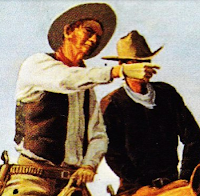 |
| Gary Miller, Author |
Other than in events where the rules or customs call for a bit in the mouth of the horse, my question would be, why 'not' use a hackamore bridle?
The hackamore (sometimes called a bosal) as applied to horses, can be traced back in history to about 4,000 BC. And they were most likely used on camels even prior to that. A hackamore bridle, properly fitted and properly applied is a more humane means of controlling a horse than most all forms of the conventional metal bit placed in its mouth. And it is most likely a better way of communicating with a young or green horse during early training. And let's face it, communication between the horse and rider is a prime necessity in horsemanship and training.
The horse’s mouth is very sensitive. It does not take much pressure on the horse's jawbone (bars) to cause intense pain. And when a metal curb chain is used under the chin, along to the metal bit in its mouth, the bone and soft tissues of the lower jaw are basically clamped between two pieces of metal. Even with a leather curb strap, a rider who is a little ham-fisted can cause excessive pain to the horse.
A simple hackamore which is based on the old bosal nose band, should be considered as an option in training and riding. If a horse is too reluctant to stop with a bosal, a mechanical hackamore with a leather curb strap applied under the chin for leverage will usually suffice. But the BEST way to stop a reluctant or runaway horse is to turn its head and force the horse to come around 180 degrees or in a full circle, or as many circles as it takes to get it stopped. And that means that even before a horse is ready to be ridden, the ground training should have included the required time to teach the horse to give its neck to a gentle pull from either side.
This takes time, but the procedure is just the simple application of rewarding the horse's 'give' by instantly releasing the tug on the lead when it complies, and then repeating the process in small increments until the horse will calmly allow you to pull its neck all the way around in both directions. A horse trained in a similar manner can eventually be ridden bareback with only a rope and halter. Yes, leg commands and rider balance play very important parts here... not to mention the state of the horse's health. But those are separate topics to be addressed possibly in other articles.
ADVERTISEMENTS
And even a conventional bridle with a metal bit is no guarantee it will stop a horse who has learned to grasp the bit between its teeth and lock the bit. This puts the horse in the driver's seat, so to speak, unless the horse can be turned around in a circle as I mentioned before.
I'm surprised that even as most modern horse trainers have adopted the more humane 'communication' methods in training, that there are not more of them who prefer to use a hackamore bridle. I worked with an old time Texas-born cowhand who like me, learned the benefits of the hackamore rather late in life. Except for buggy horses, the hackamore and / or bosal became our go to bridle for training and riding. It just made sense, especially since about 90 percent of western riding is done by neck reining which allows the rider to use just one hand on the reins rather than the two hand (direct rein) method of English style riding.
Be sure to watch the movies this week!













No comments:
Post a Comment
Thank you for your comment.